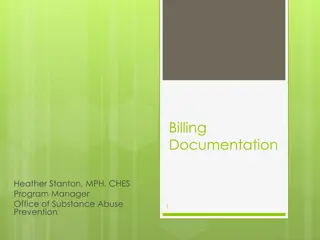Basics of Coding and Billing in Emergency Medicine
Explore the fundamentals of E/M codes, their significance in evaluating patient risk levels, and the step-by-step approach to coding charts in emergency medicine. Learn about different E/M code levels with examples and how to determine the appropriate code based on the patient's presenting problem. Gain insights into the required components for accurate coding and billing in emergency medicine.
Download Presentation

Please find below an Image/Link to download the presentation.
The content on the website is provided AS IS for your information and personal use only. It may not be sold, licensed, or shared on other websites without obtaining consent from the author.If you encounter any issues during the download, it is possible that the publisher has removed the file from their server.
You are allowed to download the files provided on this website for personal or commercial use, subject to the condition that they are used lawfully. All files are the property of their respective owners.
The content on the website is provided AS IS for your information and personal use only. It may not be sold, licensed, or shared on other websites without obtaining consent from the author.
E N D
Presentation Transcript
Coding and Billing in Emergency Medicine: The Basics Kimberly Sokol, MD, MS, MACM(c) Kaweah Delta Department of Emergency Medicine
Session Objectives By the end of the didactic session, learners will be able to 1. Define the term E/M code . 2. Determine the potential E/M code of a patient s emergency department visit based on the severity of their presenting problem. 3. State the required components of the 5 different E/M codes in terms of history, physical exam, and medical decision making.
What are E/M Codes? E/M = Evaluation and Management E/M Codes are determined by the level of risk the presenting problem poses to the patient (1 is the lowest level of risk, and 5 is the highest) Providers charts determine the E/M Code in three ways: History, Physical, and Medical and Decision Making (MDM). Bottom line: The patient s presenting problem will determine the potential code, but the provider s chart has to provide sufficient evidence to fulfill that code.
Translating Chart Level E/M Code Least Severe Level 1 = 99281 Level 2 = 99282 Level 3 = 99283 Level 4 = 99284 Level 5 = 99285 Most Severe
Step-Wise Approach to Coding Charts 1. Choose your E/M Code based on your patient s presenting problem.
Level 1 = 99281 Presenting problem: Minor, self-limited Examples: Suture removal Immunizations Medication refills
Level 2 = 99282 Presenting problem: Low to moderate severity Examples: Painful sunburn Impetigo localized to the face of a child Minor traumatic injury of an extremity Red, swollen cystic lesion on the back of an otherwise healthy patient
Level 3 = 99283 Presenting problem: Moderate severity Examples: Sexually active female presenting with vaginal discharge, normal vital signs, no abdominal pain Well-appearing child with fever and diarrhea, no signs of dehydration Inversion-type ankle injury, unable to bear weight on the injured foot/ankle
Level 4 = 99284 Presenting problem: High severity, require urgent evaluation by physician, but do not pose immediate threat to life Examples: Child with head injury and brief loss of consciousness, but neurologically intact Elderly female with right hip pain after a mechanical fall Patient with flank pain and hematuria Sexually active female with vaginal discharge AND abdominal pain
Level 5 = 99285 Presenting problem: High severity, require urgent evaluation by physician AND pose an immediate threat to life/physiologic life Examples: Complicated overdose New-onset rapid heart rate requiring IV therapy Active upper GI bleed Patient presenting after a motor vehicle collision with concerns for intraabdominal, intrathoracic, and/or multiple extremity injuries Cardiac ischemia Pulmonary embolus
Step-Wise Approach to Coding Charts 1. Choose your E/M Code based on your patient s presenting problem. 2. Once you ve chosen your E/M Code, determine the level of History needed to fulfill the requirements for that code, as determined by Centers for Medicare and Medicaid Services.
Chief Complaint Required in all patients, regardless of the level of severity This is a concise statement that describes the reason for the encounter Stated in the patient s own words Examples: My head hurts Chest pain I was in a car accident
History of Present Illness/Injury (HPI) Timing constant/intermittent, time of day, onset Context when the symptoms occur, description of events leading up to injury Duration when did symptoms start, how long ago Modifying Factors aggravating or alleviating factors Location area of body, localized, radiation of pain Quality sharp/dull, throbbing/stabbing, acute/chronic Severity pain scale (1-10), functional status Associated Signs and Symptoms includes persistent positives and negatives
Review of Systems (ROS) Constitutional Eyes Ears, nose, mouth and throat Cardiovascular Respiratory Gastrointestinal Genitourinary Allergic/Immunologic Musculoskeletal Integumentary (skin and/or breast) Neurological Psychiatric Endocrine Hematologic/Lymphatic
Review of Systems (ROS) Can state All other systems reviewed and are negative for billing purposes But this may not be medicolegally sound! Examples of UNACCEPTABLE ROS statements: ROS Noncontributory ROS All negative
Past, Family and Social History Past History: Possible Components Prior major illnesses and injuries Prior surgeries Prior hospitalizations Current medications Allergies (i.e. drug and food) Age appropriate immunization status Age appropriate feeding/dietary status
Past, Family and Social History Family History: Possible Components Health status or cause of death of parents, siblings, and children Specific diseases related to problems identified in the chief complaint, HPI, or ROS Diseases of family members which may be hereditary or place the patient at risk Cannot say non-contributory
Past, Family, and Social History Social History: Possible Components Marital status/living arrangements Current employment Occupational history Use of drugs, alcohol and/or tobacco Level of education Sexual history Other relevant social factors
Acuity Caveat If you are unable to obtain a complete history, a level 5 chart can still be obtained, but you need to document the reason why Examples: The patient is unresponsive and cannot provide any history. Patient is in extreme distress and required immediate care. Unable to obtain history due to language barrier despite my attempts to obtain an interpreter.
Step-Wise Approach to Coding Charts 1. Choose your E/M Code based on your patient s presenting problem. 2. Once you ve chosen your E/M Code, determine the level of History needed to fulfill the requirements for that code, as determined by Centers for Medicare and Medicaid Services. 3. Now that you have your history level, determine the level of Physical Exam necessary to fulfill the requirements for that code.
Physical Examination Can be done in terms of body areas OR organ systems Number of required components can be a mix of body areas and organ systems
Physical Exam (Body Areas) Head, including the face Back Neck Right arm Chest, including breasts and Left arm axilla Right leg Abdomen Left leg Genitalia, groin, buttocks
Physical Exam (Organ Systems) Constitutional (vitals, general Genitourinary condition) Musculoskeletal Eyes Skin Ears, nose, mouth and throat Neurologic Cardiovascular Psychiatric Respiratory Heme/lymph/immune Gastrointestinal
Step-Wise Approach to Coding Charts 1. Choose your E/M Code based on your patient s presenting problem. 2. Once you ve chosen your E/M Code, determine the level of History needed to fulfill the requirements for that code, as determined by Centers for Medicare and Medicaid Services. 3. Now that you have your history level, determine the level of Physical Exam necessary to fulfill the requirements for that code. 4. Complete the MDM per CMS coding standards.
3 Components of MDM 1. Diagnosis/Treatment: Number of possible diagnosis and/or management options considered 2. Data: Amount and/or complexity of medical records, diagnostic tests, and/or other information that must be obtained, reviewed, and analyzed 3. Risk: Risk of significant complications, morbidity, and/or mortality, as well as comorbidities, associated with the patient s presenting problem(s), the diagnostic procedure(s) and/or the possible management options
Step-Wise Approach to Coding Charts 1. Choose your E/M Code based on your patient s presenting problem. 2. Once you ve chosen your E/M Code, determine the level of History needed to fulfill the requirements for that code, as determined by Centers for Medicare and Medicaid Services. 3. Now that you have your history level, determine the level of Physical Exam necessary to fulfill the requirements for that code. 4. Complete the MDM per CMS coding standards. 1. Determine the level of risk of the patient.
Risk Presenting Problems Diagnostic(s) Ordered Management Options 1 self-limited or minor problem Labs, CXR, EKG, UA, ultrasound Rest, gargles, elastic bandages, superficial dressings Minimal Over the counter drugs, minor surgery with no risk factors, PT, OT, IV fluids without additives 2 or more self-limited or minor problems Physiologic tests not under stress Low 1 or more chronic illnesses with mild exacerbation Minor surgery with risk factors, elective major surgery with no risk factors, Rx drugs, Closed treatment of fracture/dislocation Physiologic test under stress Moderate Elective major surgery with risk factors, emergency major surgery, drug therapy requiring intensive monitoring for toxicity, decision not to resuscitate or deescalate care due to poor prognosis CV imaging studies with contrast, diagnostic endoscopies 1 or more chronic illnesses with severe exacerbation High
Risk The overall risk is determined by the highest level of risk in any ONE category from the previous slide.
Step-Wise Approach to Coding Charts 1. Choose your E/M Code based on your patient s presenting problem. 2. Once you ve chosen your E/M Code, determine the level of History needed to fulfill the requirements for that code, as determined by Centers for Medicare and Medicaid Services. 3. Now that you have your history level, determine the level of Physical Exam necessary to fulfill the requirements for that code. 4. Complete the MDM per CMS coding standards. 1. Determine the level of risk of the patient. 2. Once you determine the risk severity, review the other two components of the MDM, knowing that 1/2 must meet or exceed that level.
3 Components of MDM 1. Diagnosis/Treatment: Number of possible diagnosis and/or management options considered 2. Data: Amount and/or complexity of medical records, diagnostic tests, and/or other information that must be obtained, reviewed, and analyzed 3. Risk: Risk of significant complications, morbidity, and/or mortality, as well as comorbidities, associated with the patient s presenting problem(s), the diagnostic procedure(s) and/or the possible management options
Problem Categories Points Self-limited or minor (max of 2) 1 Established problem; stable or improved 1 Established problem; worsening 2 New problem; no additional workup planned (max 1) 3 New problem; additional workup planned 4
3 Components of MDM 1. Diagnosis/Treatment: Number of possible diagnosis and/or management options considered 2. Data: Amount and/or complexity of medical records, diagnostic tests, and/or other information that must be obtained, reviewed, and analyzed 3. Risk: Risk of significant complications, morbidity, and/or mortality, as well as comorbidities, associated with the patient s presenting problem(s), the diagnostic procedure(s) and/or the possible management options
Type of Data Points Review and/or order clinical lab tests 1 Review and/or order tests from radiology section of CPT 1 Review and/or order tests from medicine section of CPT (i.e. EKG) 1 Discuss test results with performing physician 1 Independent visualization of image, tracing, or specimen 2 Obtain old records and/or obtain history from someone other than patient 1 Review and summarize old records and/or discuss case with another provider 2
Step-Wise Approach to Coding Charts 1. Choose your E/M Code based on your patient s presenting problem. 2. Once you ve chosen your E/M Code, determine the level of History needed to fulfill the requirements for that code, as determined by Centers for Medicare and Medicaid Services. 3. Now that you have your history level, determine the level of Physical Exam necessary to fulfill the requirements for that code. 4. Complete the MDM per CMS coding standards. 1. Determine the level of risk of the patient. 2. Once you determine the risk severity, review the other two components of the MDM, knowing that 1/2 must meet or exceed that level. 5. Review the chart from start to finish, ensuring it is complete.























